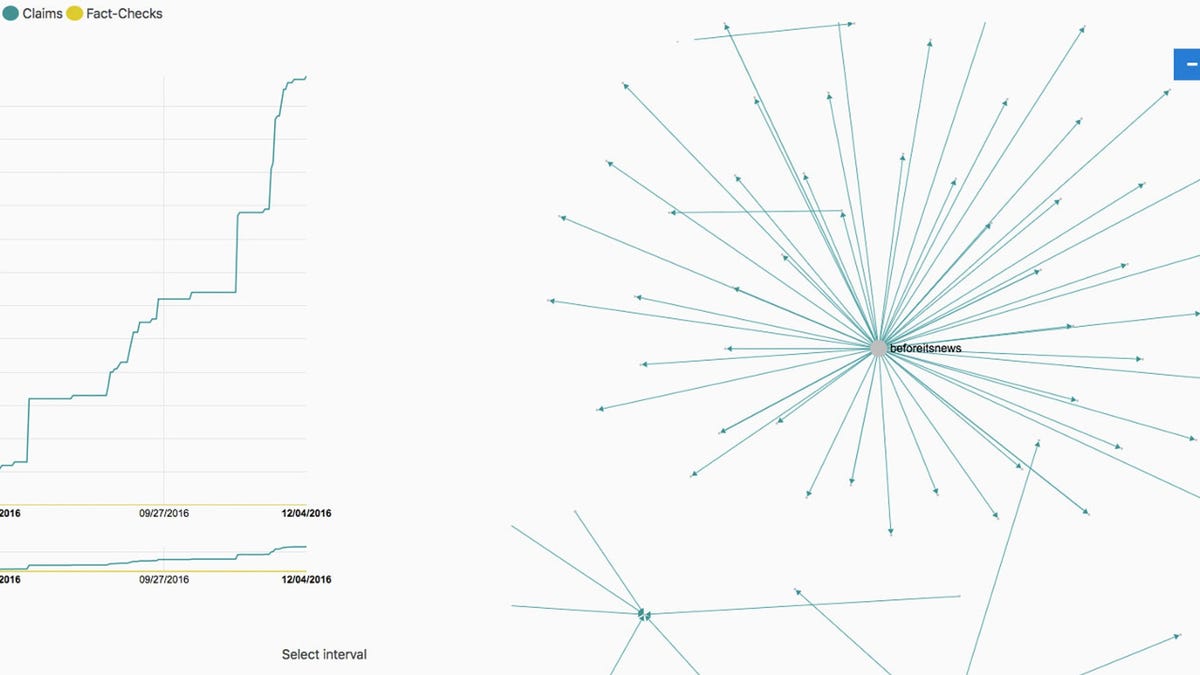Fake-news search engine tracks spread of lies
The newly created Hoaxy search engine lets you watch how phony news spreads across social media.
Now you can map the web of lies.
A beta version of Hoaxy, a search engine designed to track fake news, was released Wednesday by Indiana University's Network Science Institute and its Center for Complex Networks and System Research. Hoaxy indexes stories from 132 sites known to produce fake news, such as WashingtonPost.com.co and MSNBC.website, and allows you to see how these sites' links spread across social media.
Fake news has plagued the internet and social networks for a long time but has grown in prominence in the past year or so, forcing Facebook to introduce new features to flag false articles. The hoaxes have lead to real-life consequences, with a fake news creator taking some credit for Donald Trump's White House win and a Washington DC shooting earlier this month related to "Pizzagate." Even Pope Francis has chimed in, comparing the spread of fake news to a literal shit show.
Type any subject, and Hoaxy responds with a list of fake articles related to the search term.
There are even fake news stories about fake news. A search for "Pizzagate," for example, generates 20 results on Hoaxy. Pizzagate itself is a conspiracy theory falsely claiming Hillary Clinton helped run a child sex ring out of a Washington DC pizza place. The lies culminated with a gunman, who claimed to be investigating Pizzagate, opening fire at the targeted pizzeria on December 4.
DC restaurant Comet Ping Pong became tangled in a series of fake news stories that have been dubbed "Pizzagate."
Following the shooter's arrest, the website DC Clothesline published a fake-news article on December 6 titled "More Evidence Pizzagate Shooting is a PSYOP: The Shooter Has an IMDB Page, He's Literally An Actor." The article claims the shooting was propaganda and faked. The story claims the gunman, Edgar Maddison Welch, is an actor -- much like how Sandy Hook conspiracy theorists say the victims killed in the 2012 school shooting were also actors.
After selecting an article on Hoaxy, you can visualize its influence in two charts, one showing its popularity over time and the other showing how it spread on Twitter.
The DC Clothesline story has been shared on Twitter 137 times and 643 times on Facebook. On the chart, you can watch it move from the DC Clothesline's Twitter account through its network of followers and how the article branches off after that.
The Indiana University research center decided to build Hoaxy and track the spread of fake news to figure out how to address the public's concerns about this issue, Filippo Menczer, the center's director, said in an interview.
"Until we understand the phenomenon, we can't really develop countermeasures," Menczer said.
Using Hoaxy, you can see how the posts are connected on social media.
Hoaxy's developers generate the search results from 132 websites compiled via fake-news warning lists from watchdog sites like Snopes and Fake News Watch.
Hoaxy also tracks the spread of fact-checking articles, which Menczer found don't go as viral as fake articles do.
The search engine also appears to discover stories that may not be fake, per se, but that include a strong bias. A search for "Amazon" finds a December 1 story from Infowars.com titled "Amazon Pushes Islamic Propaganda in New 'Priest and Imam' Commercial." Infowars.com, which traffics in conspiracy theories, gained attention during the presidential campaign for spreading fake news about Democratic nominee Hillary Clinton.
The article is based on a real event: Amazon released a commercial in mid-November featuring a priest and imam that tells a story of two friends ordering gifts for each other with Amazon Prime. However, there is no "Islamic propaganda" in the commercial, just the use of heart-touching humanity to help market Amazon's member services.
The priest-imam story has been shared on Twitter 1,202 times and 6,467 times on Facebook. More than 700 of those retweets came via the Infowars editor-at-large in this tweet, while another tweet from Infowars founder Alex Jones contributed more than 150 retweets.


